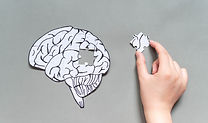.jpg)
TRAUMA & EMDR
Understanding Trauma
ANYONE can experience trauma. Its etiology can range from major life-threatening events to highly distressing non-life-threatening experiences that impact our wellbeing. Symptoms of trauma display themselves uniquely to each individual and may come in the form of:
When we experience traumatic events, our bodies take in data such as what we are seeing, hearing, tasting, feeling, and smelling. At times, our minds might struggle to take in additional information that helps us to heal, and so our trauma memories are frozen on repeat of the experience (like watching a movie replaying over-and-over again). We might also try to avoid these thoughts, but OUR BODIES REMEMBER. A certain scent might trigger a reaction, a sound might elicit a distressing response, or seeing something that represents a traumatic experience might lead to heightened levels of disturbance. With trauma, we often develop negative thinking patterns about ourselves. However, HEALING IS POSSIBLE. Evidenced-based approaches such as Eye Movement Desensitization and Reprocessing (EMDR) have been shown to help us to reduce emotional arousal and disturbing symptoms we feel when recalling these distressing traumatic memories. It is designed to help us to take in adaptive information, so that we can see ourselves in healthier ways.
-
Experiencing upsetting memories replaying in your mind
-
Having nightmares or flashbacks about an event that occurred
-
Finding yourself feeling on “high alert”
-
Reacting to certain internal or external cues that remind you of a negative experience
-
Avoiding situations, people, thoughts, memories, or feelings that remind you of a distressing event
-
Observing negative beliefs about yourself or disturbing emotions related to a previous situation
-
Finding yourself in a dreamlike state or struggling to concentrate on the present moment
What Is EMDR?
Eye Movement Desensitization and Reprocessing (EMDR) is a widely researched therapy shown to help people to heal from traumatic or distressing life experiences. The development of EMDR (originally termed EMD) occurred in 1987 by Francine Shapiro, who noticed a reduction in emotional arousal when bilateral eye movements occurring simultaneously when thinking about a distressing event (www.emdr.com/history-of-emdr/) . Since then, research studies, including meta-analyses, have indicated EMDR is an effective therapy for Post-Traumatic Stress Disorder among other conditions such as depression, anxiety, and panic disorders. Rather than replaying the disturbing memory, EMDR helps to reprocess the memory with integration of adaptive information, which can lead to less emotional arousal and healthier views of oneself. Its focus is on three time periods: one's past, present, and future.
The 8 Stages of EMDR include:
STAGE 1: TREATMENT PLANNING

-
Getting to know your history, including presenting struggles, goals, and supports
-
Creating a list of, and categorize, traumatic events
-
Create a treatment plan
-
Assessing readiness for EMDR stages
STAGE 3: ASSESSMENT

-
Select a traumatic memory
-
Select an image that represents the memory
-
Identify a negative thought you might be experiencing
-
Select a preferred positive belief that you would like to work toward
STAGE 2: PREPARATION

-
Discuss EMDR Theory and Model
-
Identifying a Safe Place
-
Discuss possible side effects
-
Learn stress management techniques
STAGE 4: DESENSITIZATION

-
While thinking about the target memory, track your clinician's finger movements with your eyes (alternative modes include taps or tones)
-
Explain briefly what you notice in between sets
-
The clinician will occasionally ask for a rating of intensity
-
The image/memory becomes less upsetting
STAGE 5: INSTALLATION

-
Linking the preferred positive belief with the trauma also using eye movements or alternative modes
-
The clinician will occasionally ask for a rating of how strongly you believe the positive cognition
STAGE 7: CLOSURE

-
Containment, orient self to the present
-
Debrief
-
Homework - Notice Log
STAGE 6: BODY SCAN

-
Scanning your body for any disturbance that might still be present
-
Eye movements or alternative modes of bilateral stimulation utilized
STAGE 8: RE-EVALUATION

-
Examine progress
-
Check Notice Log
-
Assess need for movement through past/present/future targets